Business Economics Report: Spotify, Adidas, and Macroeconomics
VerifiedAdded on 2023/04/08
|15
|2983
|361
Report
AI Summary
This report provides a comprehensive analysis of business economics principles applied to Spotify and Adidas. Part A examines Spotify's growth, market factors, and cross-price elasticity in relation to Apple Music. Part B delves into Adidas's market structure, competitive landscape, and celebrity endorsement strategies, including the impact of endorsements by figures like Kanye West. The report further explores the macroeconomic effects of investment in digital marketing by Adidas, analyzing its impact on aggregate demand and national income. The report utilizes economic models and figures to illustrate key concepts and provides a detailed overview of the companies' strategies and the economic forces shaping their performance. It addresses topics such as monopolistic competition, supply and demand, and the influence of celebrity endorsements on brand value and market dynamics.
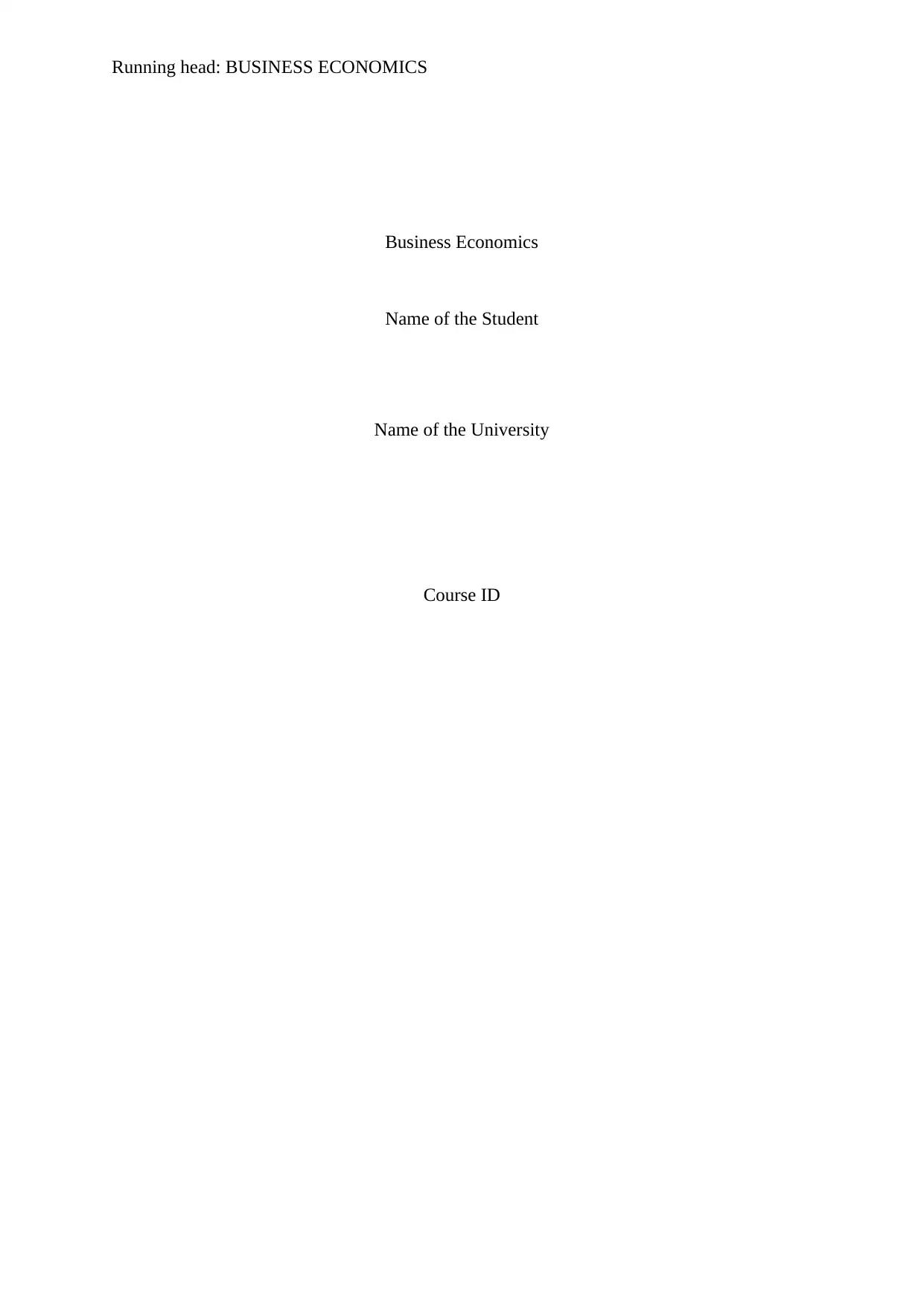
Running head: BUSINESS ECONOMICS
Business Economics
Name of the Student
Name of the University
Course ID
Business Economics
Name of the Student
Name of the University
Course ID
Paraphrase This Document
Need a fresh take? Get an instant paraphrase of this document with our AI Paraphraser
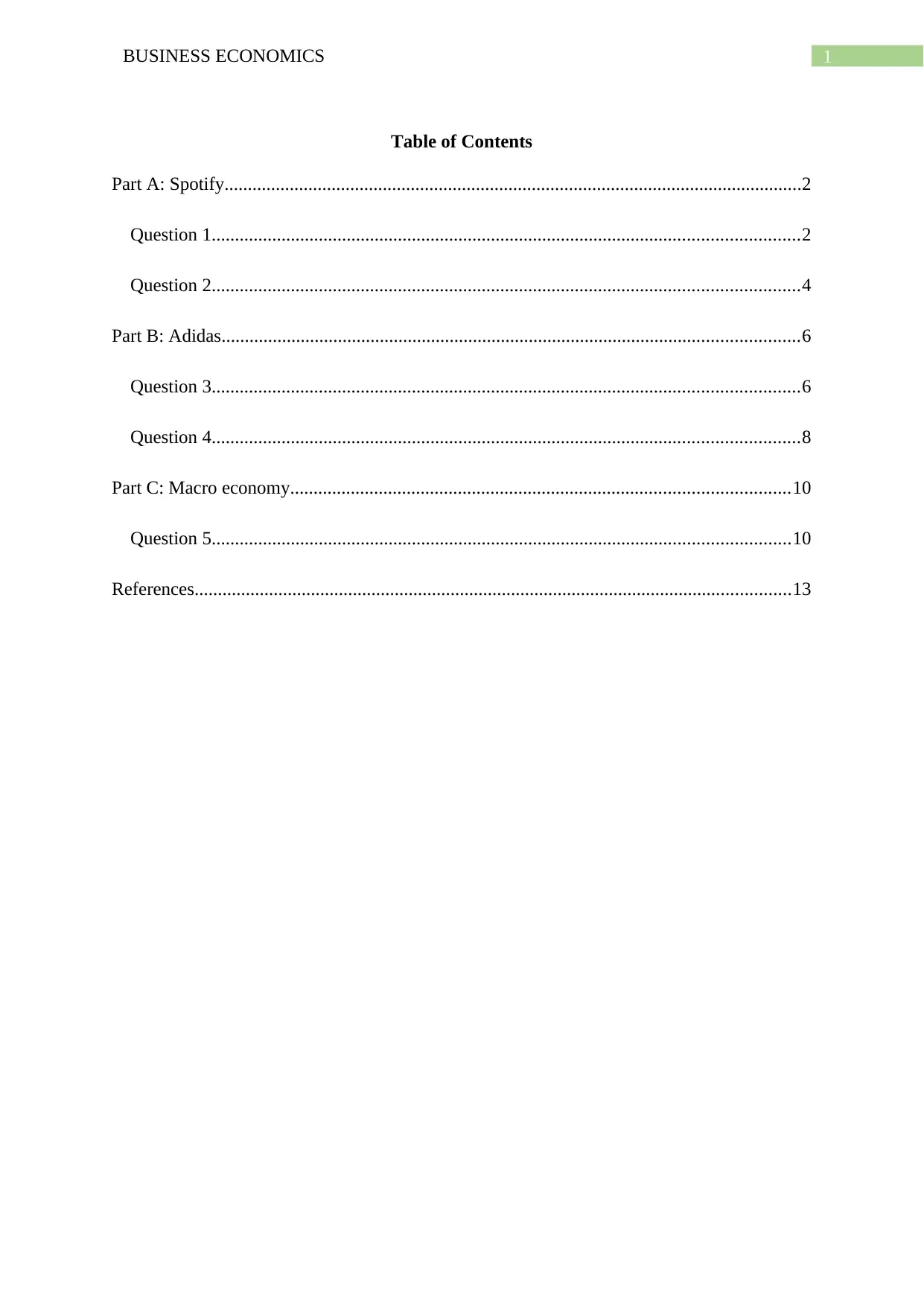
1BUSINESS ECONOMICS
Table of Contents
Part A: Spotify............................................................................................................................2
Question 1..............................................................................................................................2
Question 2..............................................................................................................................4
Part B: Adidas............................................................................................................................6
Question 3..............................................................................................................................6
Question 4..............................................................................................................................8
Part C: Macro economy...........................................................................................................10
Question 5............................................................................................................................10
References................................................................................................................................13
Table of Contents
Part A: Spotify............................................................................................................................2
Question 1..............................................................................................................................2
Question 2..............................................................................................................................4
Part B: Adidas............................................................................................................................6
Question 3..............................................................................................................................6
Question 4..............................................................................................................................8
Part C: Macro economy...........................................................................................................10
Question 5............................................................................................................................10
References................................................................................................................................13
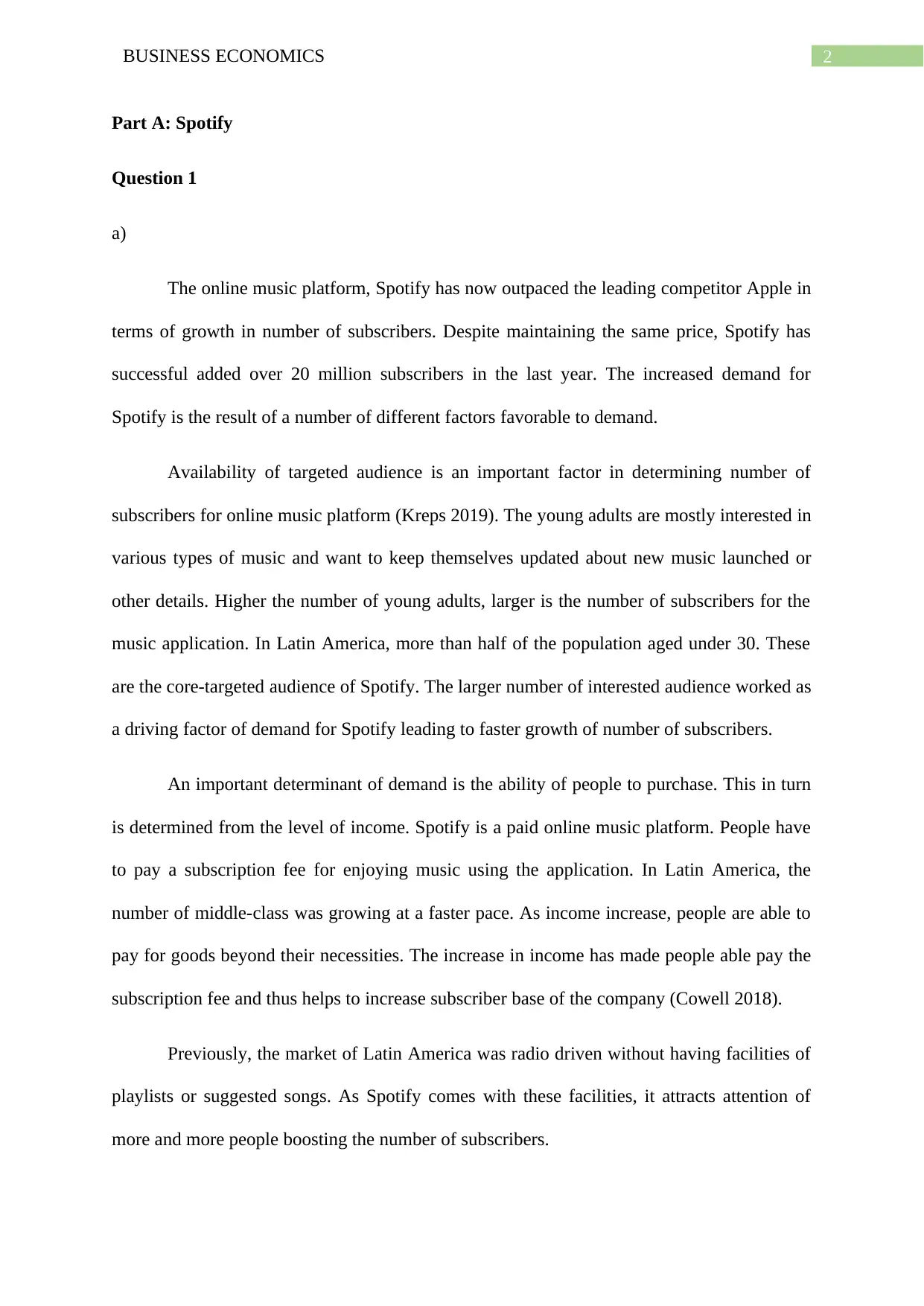
2BUSINESS ECONOMICS
Part A: Spotify
Question 1
a)
The online music platform, Spotify has now outpaced the leading competitor Apple in
terms of growth in number of subscribers. Despite maintaining the same price, Spotify has
successful added over 20 million subscribers in the last year. The increased demand for
Spotify is the result of a number of different factors favorable to demand.
Availability of targeted audience is an important factor in determining number of
subscribers for online music platform (Kreps 2019). The young adults are mostly interested in
various types of music and want to keep themselves updated about new music launched or
other details. Higher the number of young adults, larger is the number of subscribers for the
music application. In Latin America, more than half of the population aged under 30. These
are the core-targeted audience of Spotify. The larger number of interested audience worked as
a driving factor of demand for Spotify leading to faster growth of number of subscribers.
An important determinant of demand is the ability of people to purchase. This in turn
is determined from the level of income. Spotify is a paid online music platform. People have
to pay a subscription fee for enjoying music using the application. In Latin America, the
number of middle-class was growing at a faster pace. As income increase, people are able to
pay for goods beyond their necessities. The increase in income has made people able pay the
subscription fee and thus helps to increase subscriber base of the company (Cowell 2018).
Previously, the market of Latin America was radio driven without having facilities of
playlists or suggested songs. As Spotify comes with these facilities, it attracts attention of
more and more people boosting the number of subscribers.
Part A: Spotify
Question 1
a)
The online music platform, Spotify has now outpaced the leading competitor Apple in
terms of growth in number of subscribers. Despite maintaining the same price, Spotify has
successful added over 20 million subscribers in the last year. The increased demand for
Spotify is the result of a number of different factors favorable to demand.
Availability of targeted audience is an important factor in determining number of
subscribers for online music platform (Kreps 2019). The young adults are mostly interested in
various types of music and want to keep themselves updated about new music launched or
other details. Higher the number of young adults, larger is the number of subscribers for the
music application. In Latin America, more than half of the population aged under 30. These
are the core-targeted audience of Spotify. The larger number of interested audience worked as
a driving factor of demand for Spotify leading to faster growth of number of subscribers.
An important determinant of demand is the ability of people to purchase. This in turn
is determined from the level of income. Spotify is a paid online music platform. People have
to pay a subscription fee for enjoying music using the application. In Latin America, the
number of middle-class was growing at a faster pace. As income increase, people are able to
pay for goods beyond their necessities. The increase in income has made people able pay the
subscription fee and thus helps to increase subscriber base of the company (Cowell 2018).
Previously, the market of Latin America was radio driven without having facilities of
playlists or suggested songs. As Spotify comes with these facilities, it attracts attention of
more and more people boosting the number of subscribers.
⊘ This is a preview!⊘
Do you want full access?
Subscribe today to unlock all pages.

Trusted by 1+ million students worldwide

3BUSINESS ECONOMICS
b)
Several factors influence supply of a commodity. Favorable business condition helps
to increase supply of a commodity. Regulation plays an important role in determining supply.
Strict regulation such as complicated license procedure hampers production and supply. In
contrast easy access to license helps to boost supply (McKenzie and Lee 2016). The audio
streaming platform needs license to operate in a nation. In Latin America, licensing is
relatively easy because there is still threat of doing piracy. This implies big brands can
happily operate in the country. The easy accessibility of license has helped Spotify to operate
successfully in Latin America.
c)
Cross price elasticity of demand refers to a measure of elasticity that indicate
proportionate change in quantity demanded demand of a commodity for a corresponding
change in the price of related good. In case of substitute goods, increase in price of one good
raises demand of the related goods and cross price elasticity of demand is positive (Friedman
2017). For complementary goods, an increase in price of one good reduces demand for the
complementary good. The cross price elasticity of demand in this case is negative.
Cross price elasticity of demand= Percentage ∈quantity demanded
Percentage change ∈ price of the related good
Example:
Suppose an increase in price of tea from Rs.10 per 100 grams to Rs. 15 per 100 grams
results in an increase in demand for coffee from 30/100 grams to 40/100 grams, then cross
price elasticity of demand between tea and coffee can be computed as
Percentage change in quantity demanded of coffee = (40 – 30)/ 30 *100 = 33.33%
b)
Several factors influence supply of a commodity. Favorable business condition helps
to increase supply of a commodity. Regulation plays an important role in determining supply.
Strict regulation such as complicated license procedure hampers production and supply. In
contrast easy access to license helps to boost supply (McKenzie and Lee 2016). The audio
streaming platform needs license to operate in a nation. In Latin America, licensing is
relatively easy because there is still threat of doing piracy. This implies big brands can
happily operate in the country. The easy accessibility of license has helped Spotify to operate
successfully in Latin America.
c)
Cross price elasticity of demand refers to a measure of elasticity that indicate
proportionate change in quantity demanded demand of a commodity for a corresponding
change in the price of related good. In case of substitute goods, increase in price of one good
raises demand of the related goods and cross price elasticity of demand is positive (Friedman
2017). For complementary goods, an increase in price of one good reduces demand for the
complementary good. The cross price elasticity of demand in this case is negative.
Cross price elasticity of demand= Percentage ∈quantity demanded
Percentage change ∈ price of the related good
Example:
Suppose an increase in price of tea from Rs.10 per 100 grams to Rs. 15 per 100 grams
results in an increase in demand for coffee from 30/100 grams to 40/100 grams, then cross
price elasticity of demand between tea and coffee can be computed as
Percentage change in quantity demanded of coffee = (40 – 30)/ 30 *100 = 33.33%
Paraphrase This Document
Need a fresh take? Get an instant paraphrase of this document with our AI Paraphraser
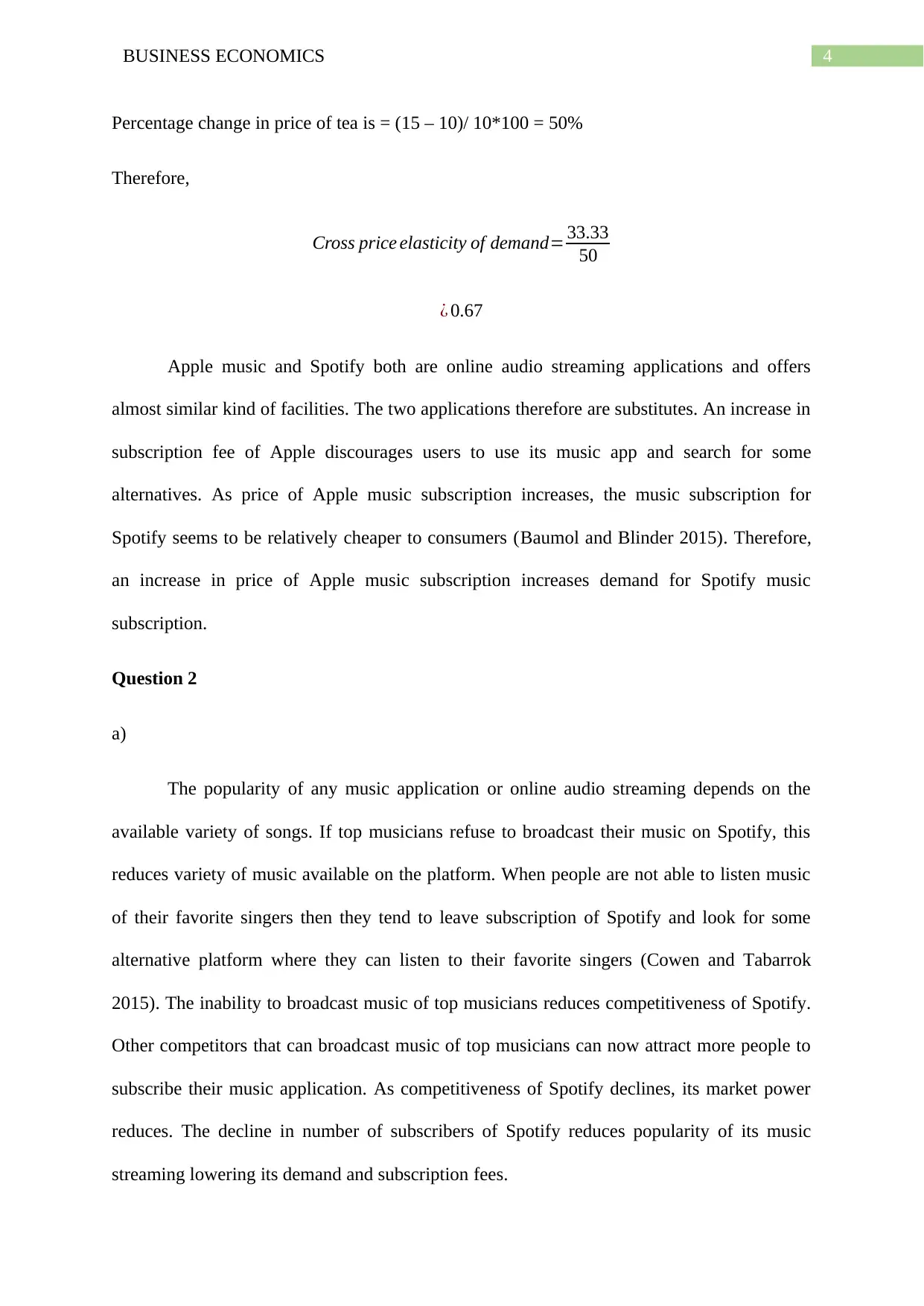
4BUSINESS ECONOMICS
Percentage change in price of tea is = (15 – 10)/ 10*100 = 50%
Therefore,
Cross price elasticity of demand= 33.33
50
¿ 0.67
Apple music and Spotify both are online audio streaming applications and offers
almost similar kind of facilities. The two applications therefore are substitutes. An increase in
subscription fee of Apple discourages users to use its music app and search for some
alternatives. As price of Apple music subscription increases, the music subscription for
Spotify seems to be relatively cheaper to consumers (Baumol and Blinder 2015). Therefore,
an increase in price of Apple music subscription increases demand for Spotify music
subscription.
Question 2
a)
The popularity of any music application or online audio streaming depends on the
available variety of songs. If top musicians refuse to broadcast their music on Spotify, this
reduces variety of music available on the platform. When people are not able to listen music
of their favorite singers then they tend to leave subscription of Spotify and look for some
alternative platform where they can listen to their favorite singers (Cowen and Tabarrok
2015). The inability to broadcast music of top musicians reduces competitiveness of Spotify.
Other competitors that can broadcast music of top musicians can now attract more people to
subscribe their music application. As competitiveness of Spotify declines, its market power
reduces. The decline in number of subscribers of Spotify reduces popularity of its music
streaming lowering its demand and subscription fees.
Percentage change in price of tea is = (15 – 10)/ 10*100 = 50%
Therefore,
Cross price elasticity of demand= 33.33
50
¿ 0.67
Apple music and Spotify both are online audio streaming applications and offers
almost similar kind of facilities. The two applications therefore are substitutes. An increase in
subscription fee of Apple discourages users to use its music app and search for some
alternatives. As price of Apple music subscription increases, the music subscription for
Spotify seems to be relatively cheaper to consumers (Baumol and Blinder 2015). Therefore,
an increase in price of Apple music subscription increases demand for Spotify music
subscription.
Question 2
a)
The popularity of any music application or online audio streaming depends on the
available variety of songs. If top musicians refuse to broadcast their music on Spotify, this
reduces variety of music available on the platform. When people are not able to listen music
of their favorite singers then they tend to leave subscription of Spotify and look for some
alternative platform where they can listen to their favorite singers (Cowen and Tabarrok
2015). The inability to broadcast music of top musicians reduces competitiveness of Spotify.
Other competitors that can broadcast music of top musicians can now attract more people to
subscribe their music application. As competitiveness of Spotify declines, its market power
reduces. The decline in number of subscribers of Spotify reduces popularity of its music
streaming lowering its demand and subscription fees.
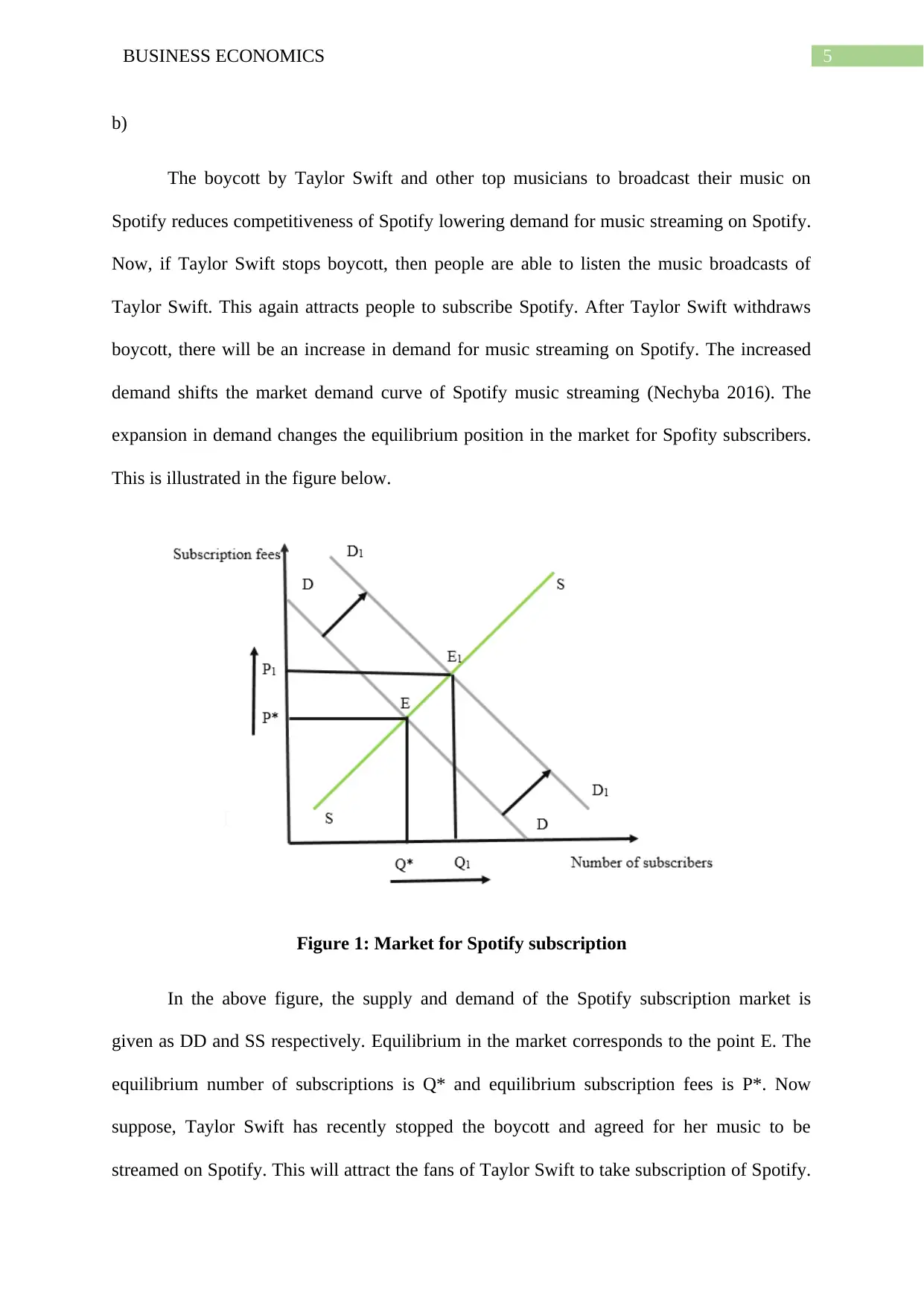
5BUSINESS ECONOMICS
b)
The boycott by Taylor Swift and other top musicians to broadcast their music on
Spotify reduces competitiveness of Spotify lowering demand for music streaming on Spotify.
Now, if Taylor Swift stops boycott, then people are able to listen the music broadcasts of
Taylor Swift. This again attracts people to subscribe Spotify. After Taylor Swift withdraws
boycott, there will be an increase in demand for music streaming on Spotify. The increased
demand shifts the market demand curve of Spotify music streaming (Nechyba 2016). The
expansion in demand changes the equilibrium position in the market for Spofity subscribers.
This is illustrated in the figure below.
Figure 1: Market for Spotify subscription
In the above figure, the supply and demand of the Spotify subscription market is
given as DD and SS respectively. Equilibrium in the market corresponds to the point E. The
equilibrium number of subscriptions is Q* and equilibrium subscription fees is P*. Now
suppose, Taylor Swift has recently stopped the boycott and agreed for her music to be
streamed on Spotify. This will attract the fans of Taylor Swift to take subscription of Spotify.
b)
The boycott by Taylor Swift and other top musicians to broadcast their music on
Spotify reduces competitiveness of Spotify lowering demand for music streaming on Spotify.
Now, if Taylor Swift stops boycott, then people are able to listen the music broadcasts of
Taylor Swift. This again attracts people to subscribe Spotify. After Taylor Swift withdraws
boycott, there will be an increase in demand for music streaming on Spotify. The increased
demand shifts the market demand curve of Spotify music streaming (Nechyba 2016). The
expansion in demand changes the equilibrium position in the market for Spofity subscribers.
This is illustrated in the figure below.
Figure 1: Market for Spotify subscription
In the above figure, the supply and demand of the Spotify subscription market is
given as DD and SS respectively. Equilibrium in the market corresponds to the point E. The
equilibrium number of subscriptions is Q* and equilibrium subscription fees is P*. Now
suppose, Taylor Swift has recently stopped the boycott and agreed for her music to be
streamed on Spotify. This will attract the fans of Taylor Swift to take subscription of Spotify.
⊘ This is a preview!⊘
Do you want full access?
Subscribe today to unlock all pages.

Trusted by 1+ million students worldwide
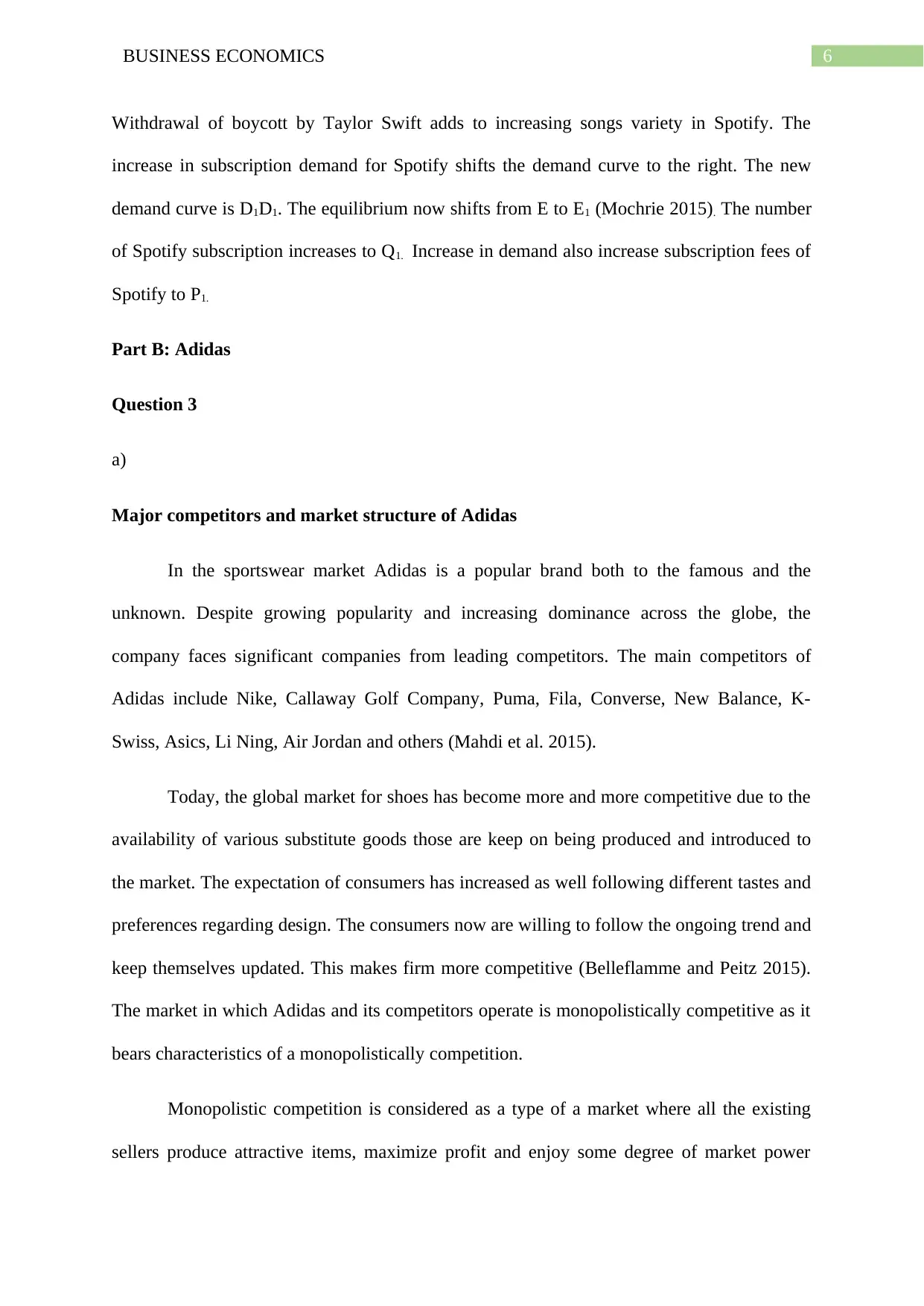
6BUSINESS ECONOMICS
Withdrawal of boycott by Taylor Swift adds to increasing songs variety in Spotify. The
increase in subscription demand for Spotify shifts the demand curve to the right. The new
demand curve is D1D1. The equilibrium now shifts from E to E1 (Mochrie 2015). The number
of Spotify subscription increases to Q1. Increase in demand also increase subscription fees of
Spotify to P1.
Part B: Adidas
Question 3
a)
Major competitors and market structure of Adidas
In the sportswear market Adidas is a popular brand both to the famous and the
unknown. Despite growing popularity and increasing dominance across the globe, the
company faces significant companies from leading competitors. The main competitors of
Adidas include Nike, Callaway Golf Company, Puma, Fila, Converse, New Balance, K-
Swiss, Asics, Li Ning, Air Jordan and others (Mahdi et al. 2015).
Today, the global market for shoes has become more and more competitive due to the
availability of various substitute goods those are keep on being produced and introduced to
the market. The expectation of consumers has increased as well following different tastes and
preferences regarding design. The consumers now are willing to follow the ongoing trend and
keep themselves updated. This makes firm more competitive (Belleflamme and Peitz 2015).
The market in which Adidas and its competitors operate is monopolistically competitive as it
bears characteristics of a monopolistically competition.
Monopolistic competition is considered as a type of a market where all the existing
sellers produce attractive items, maximize profit and enjoy some degree of market power
Withdrawal of boycott by Taylor Swift adds to increasing songs variety in Spotify. The
increase in subscription demand for Spotify shifts the demand curve to the right. The new
demand curve is D1D1. The equilibrium now shifts from E to E1 (Mochrie 2015). The number
of Spotify subscription increases to Q1. Increase in demand also increase subscription fees of
Spotify to P1.
Part B: Adidas
Question 3
a)
Major competitors and market structure of Adidas
In the sportswear market Adidas is a popular brand both to the famous and the
unknown. Despite growing popularity and increasing dominance across the globe, the
company faces significant companies from leading competitors. The main competitors of
Adidas include Nike, Callaway Golf Company, Puma, Fila, Converse, New Balance, K-
Swiss, Asics, Li Ning, Air Jordan and others (Mahdi et al. 2015).
Today, the global market for shoes has become more and more competitive due to the
availability of various substitute goods those are keep on being produced and introduced to
the market. The expectation of consumers has increased as well following different tastes and
preferences regarding design. The consumers now are willing to follow the ongoing trend and
keep themselves updated. This makes firm more competitive (Belleflamme and Peitz 2015).
The market in which Adidas and its competitors operate is monopolistically competitive as it
bears characteristics of a monopolistically competition.
Monopolistic competition is considered as a type of a market where all the existing
sellers produce attractive items, maximize profit and enjoy some degree of market power
Paraphrase This Document
Need a fresh take? Get an instant paraphrase of this document with our AI Paraphraser
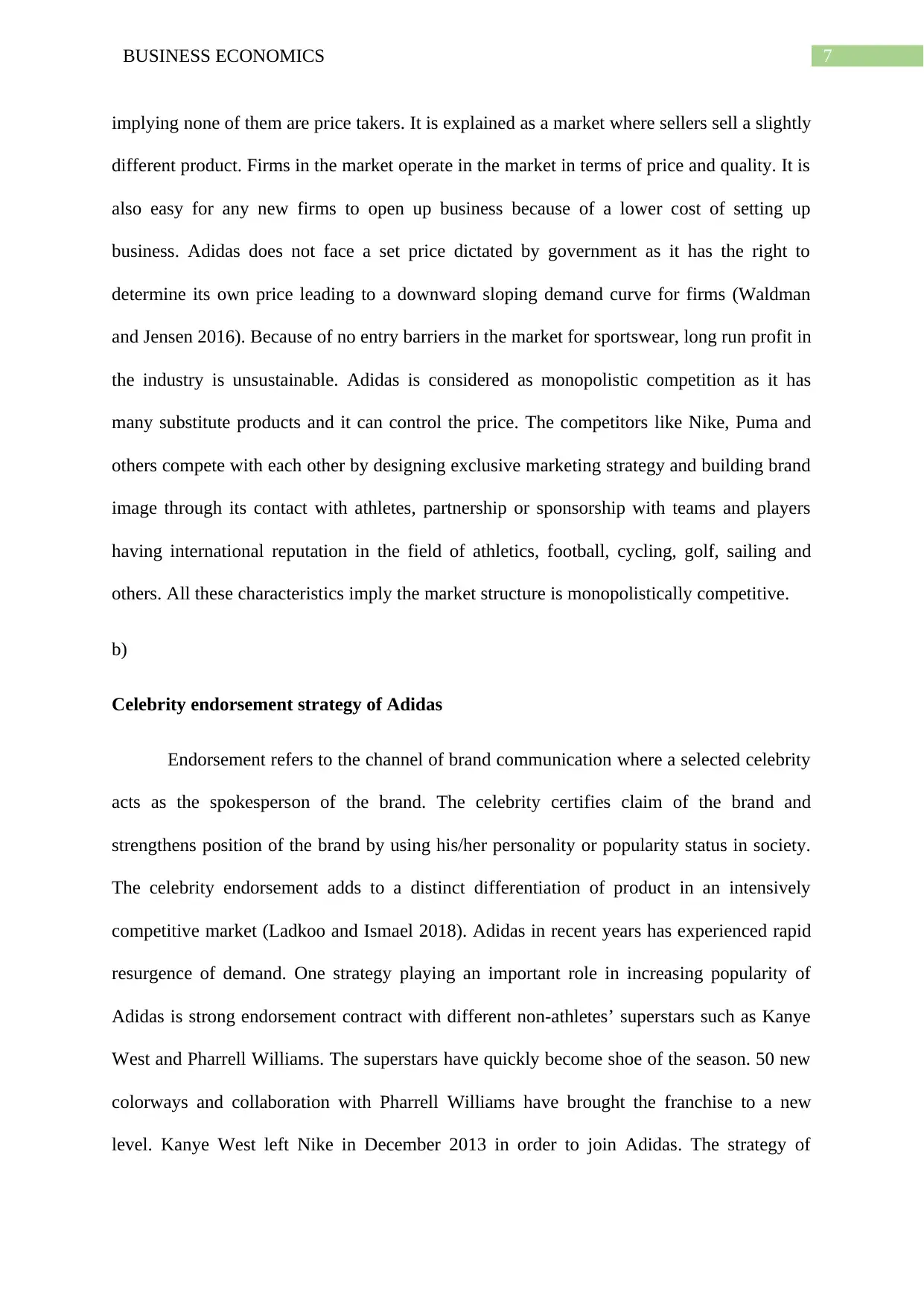
7BUSINESS ECONOMICS
implying none of them are price takers. It is explained as a market where sellers sell a slightly
different product. Firms in the market operate in the market in terms of price and quality. It is
also easy for any new firms to open up business because of a lower cost of setting up
business. Adidas does not face a set price dictated by government as it has the right to
determine its own price leading to a downward sloping demand curve for firms (Waldman
and Jensen 2016). Because of no entry barriers in the market for sportswear, long run profit in
the industry is unsustainable. Adidas is considered as monopolistic competition as it has
many substitute products and it can control the price. The competitors like Nike, Puma and
others compete with each other by designing exclusive marketing strategy and building brand
image through its contact with athletes, partnership or sponsorship with teams and players
having international reputation in the field of athletics, football, cycling, golf, sailing and
others. All these characteristics imply the market structure is monopolistically competitive.
b)
Celebrity endorsement strategy of Adidas
Endorsement refers to the channel of brand communication where a selected celebrity
acts as the spokesperson of the brand. The celebrity certifies claim of the brand and
strengthens position of the brand by using his/her personality or popularity status in society.
The celebrity endorsement adds to a distinct differentiation of product in an intensively
competitive market (Ladkoo and Ismael 2018). Adidas in recent years has experienced rapid
resurgence of demand. One strategy playing an important role in increasing popularity of
Adidas is strong endorsement contract with different non-athletes’ superstars such as Kanye
West and Pharrell Williams. The superstars have quickly become shoe of the season. 50 new
colorways and collaboration with Pharrell Williams have brought the franchise to a new
level. Kanye West left Nike in December 2013 in order to join Adidas. The strategy of
implying none of them are price takers. It is explained as a market where sellers sell a slightly
different product. Firms in the market operate in the market in terms of price and quality. It is
also easy for any new firms to open up business because of a lower cost of setting up
business. Adidas does not face a set price dictated by government as it has the right to
determine its own price leading to a downward sloping demand curve for firms (Waldman
and Jensen 2016). Because of no entry barriers in the market for sportswear, long run profit in
the industry is unsustainable. Adidas is considered as monopolistic competition as it has
many substitute products and it can control the price. The competitors like Nike, Puma and
others compete with each other by designing exclusive marketing strategy and building brand
image through its contact with athletes, partnership or sponsorship with teams and players
having international reputation in the field of athletics, football, cycling, golf, sailing and
others. All these characteristics imply the market structure is monopolistically competitive.
b)
Celebrity endorsement strategy of Adidas
Endorsement refers to the channel of brand communication where a selected celebrity
acts as the spokesperson of the brand. The celebrity certifies claim of the brand and
strengthens position of the brand by using his/her personality or popularity status in society.
The celebrity endorsement adds to a distinct differentiation of product in an intensively
competitive market (Ladkoo and Ismael 2018). Adidas in recent years has experienced rapid
resurgence of demand. One strategy playing an important role in increasing popularity of
Adidas is strong endorsement contract with different non-athletes’ superstars such as Kanye
West and Pharrell Williams. The superstars have quickly become shoe of the season. 50 new
colorways and collaboration with Pharrell Williams have brought the franchise to a new
level. Kanye West left Nike in December 2013 in order to join Adidas. The strategy of
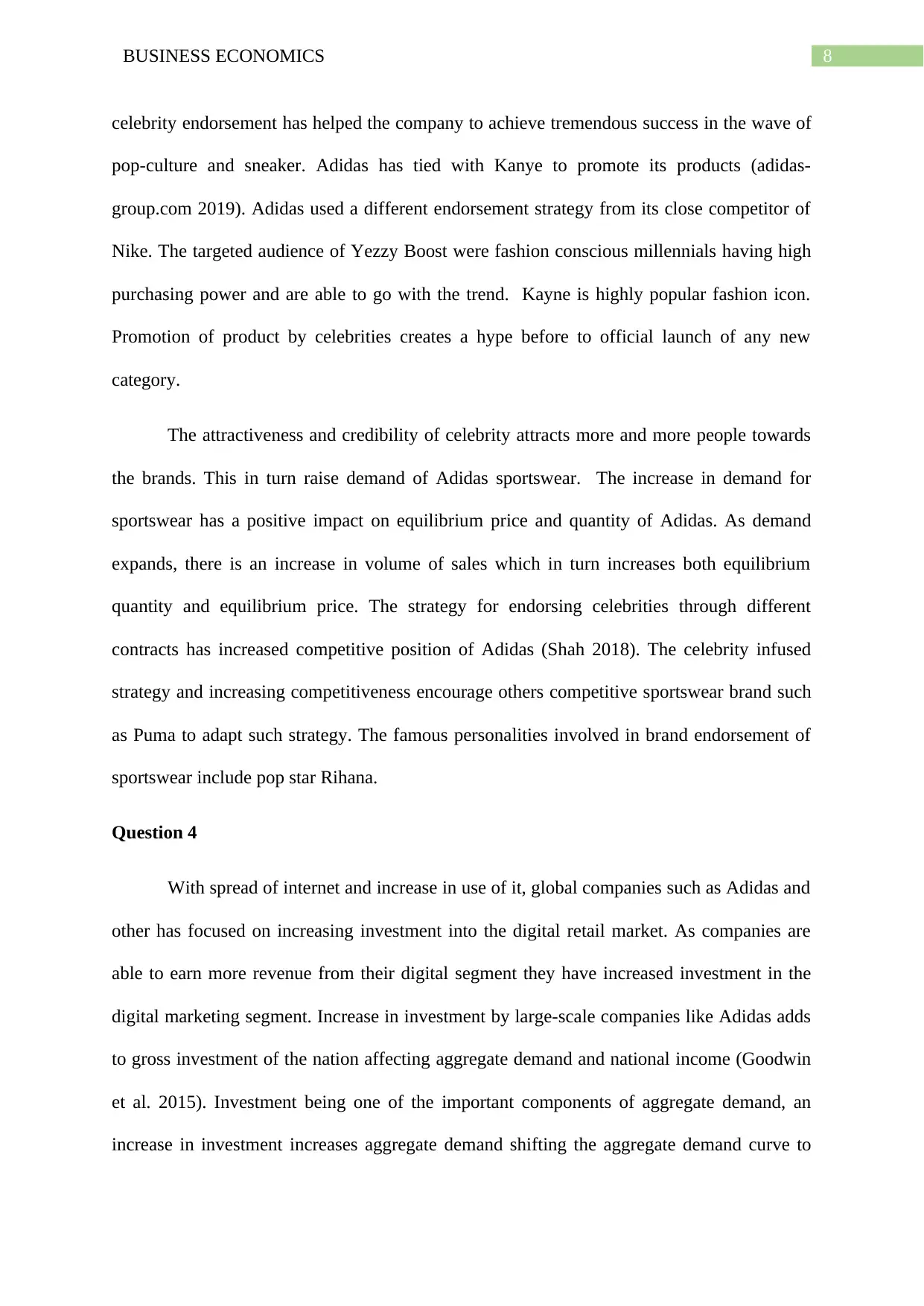
8BUSINESS ECONOMICS
celebrity endorsement has helped the company to achieve tremendous success in the wave of
pop-culture and sneaker. Adidas has tied with Kanye to promote its products (adidas-
group.com 2019). Adidas used a different endorsement strategy from its close competitor of
Nike. The targeted audience of Yezzy Boost were fashion conscious millennials having high
purchasing power and are able to go with the trend. Kayne is highly popular fashion icon.
Promotion of product by celebrities creates a hype before to official launch of any new
category.
The attractiveness and credibility of celebrity attracts more and more people towards
the brands. This in turn raise demand of Adidas sportswear. The increase in demand for
sportswear has a positive impact on equilibrium price and quantity of Adidas. As demand
expands, there is an increase in volume of sales which in turn increases both equilibrium
quantity and equilibrium price. The strategy for endorsing celebrities through different
contracts has increased competitive position of Adidas (Shah 2018). The celebrity infused
strategy and increasing competitiveness encourage others competitive sportswear brand such
as Puma to adapt such strategy. The famous personalities involved in brand endorsement of
sportswear include pop star Rihana.
Question 4
With spread of internet and increase in use of it, global companies such as Adidas and
other has focused on increasing investment into the digital retail market. As companies are
able to earn more revenue from their digital segment they have increased investment in the
digital marketing segment. Increase in investment by large-scale companies like Adidas adds
to gross investment of the nation affecting aggregate demand and national income (Goodwin
et al. 2015). Investment being one of the important components of aggregate demand, an
increase in investment increases aggregate demand shifting the aggregate demand curve to
celebrity endorsement has helped the company to achieve tremendous success in the wave of
pop-culture and sneaker. Adidas has tied with Kanye to promote its products (adidas-
group.com 2019). Adidas used a different endorsement strategy from its close competitor of
Nike. The targeted audience of Yezzy Boost were fashion conscious millennials having high
purchasing power and are able to go with the trend. Kayne is highly popular fashion icon.
Promotion of product by celebrities creates a hype before to official launch of any new
category.
The attractiveness and credibility of celebrity attracts more and more people towards
the brands. This in turn raise demand of Adidas sportswear. The increase in demand for
sportswear has a positive impact on equilibrium price and quantity of Adidas. As demand
expands, there is an increase in volume of sales which in turn increases both equilibrium
quantity and equilibrium price. The strategy for endorsing celebrities through different
contracts has increased competitive position of Adidas (Shah 2018). The celebrity infused
strategy and increasing competitiveness encourage others competitive sportswear brand such
as Puma to adapt such strategy. The famous personalities involved in brand endorsement of
sportswear include pop star Rihana.
Question 4
With spread of internet and increase in use of it, global companies such as Adidas and
other has focused on increasing investment into the digital retail market. As companies are
able to earn more revenue from their digital segment they have increased investment in the
digital marketing segment. Increase in investment by large-scale companies like Adidas adds
to gross investment of the nation affecting aggregate demand and national income (Goodwin
et al. 2015). Investment being one of the important components of aggregate demand, an
increase in investment increases aggregate demand shifting the aggregate demand curve to
⊘ This is a preview!⊘
Do you want full access?
Subscribe today to unlock all pages.

Trusted by 1+ million students worldwide
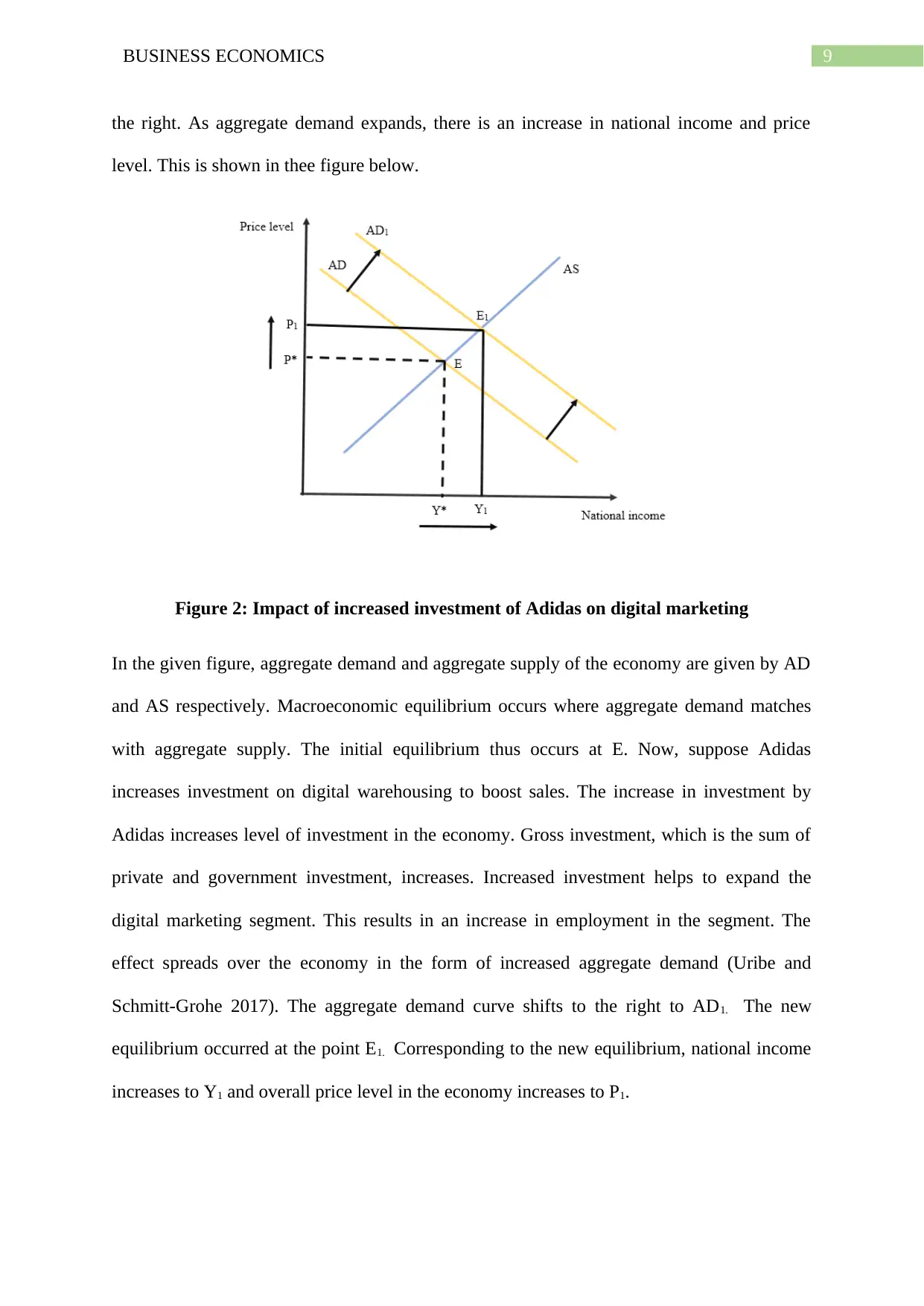
9BUSINESS ECONOMICS
the right. As aggregate demand expands, there is an increase in national income and price
level. This is shown in thee figure below.
Figure 2: Impact of increased investment of Adidas on digital marketing
In the given figure, aggregate demand and aggregate supply of the economy are given by AD
and AS respectively. Macroeconomic equilibrium occurs where aggregate demand matches
with aggregate supply. The initial equilibrium thus occurs at E. Now, suppose Adidas
increases investment on digital warehousing to boost sales. The increase in investment by
Adidas increases level of investment in the economy. Gross investment, which is the sum of
private and government investment, increases. Increased investment helps to expand the
digital marketing segment. This results in an increase in employment in the segment. The
effect spreads over the economy in the form of increased aggregate demand (Uribe and
Schmitt-Grohe 2017). The aggregate demand curve shifts to the right to AD1. The new
equilibrium occurred at the point E1. Corresponding to the new equilibrium, national income
increases to Y1 and overall price level in the economy increases to P1.
the right. As aggregate demand expands, there is an increase in national income and price
level. This is shown in thee figure below.
Figure 2: Impact of increased investment of Adidas on digital marketing
In the given figure, aggregate demand and aggregate supply of the economy are given by AD
and AS respectively. Macroeconomic equilibrium occurs where aggregate demand matches
with aggregate supply. The initial equilibrium thus occurs at E. Now, suppose Adidas
increases investment on digital warehousing to boost sales. The increase in investment by
Adidas increases level of investment in the economy. Gross investment, which is the sum of
private and government investment, increases. Increased investment helps to expand the
digital marketing segment. This results in an increase in employment in the segment. The
effect spreads over the economy in the form of increased aggregate demand (Uribe and
Schmitt-Grohe 2017). The aggregate demand curve shifts to the right to AD1. The new
equilibrium occurred at the point E1. Corresponding to the new equilibrium, national income
increases to Y1 and overall price level in the economy increases to P1.
Paraphrase This Document
Need a fresh take? Get an instant paraphrase of this document with our AI Paraphraser
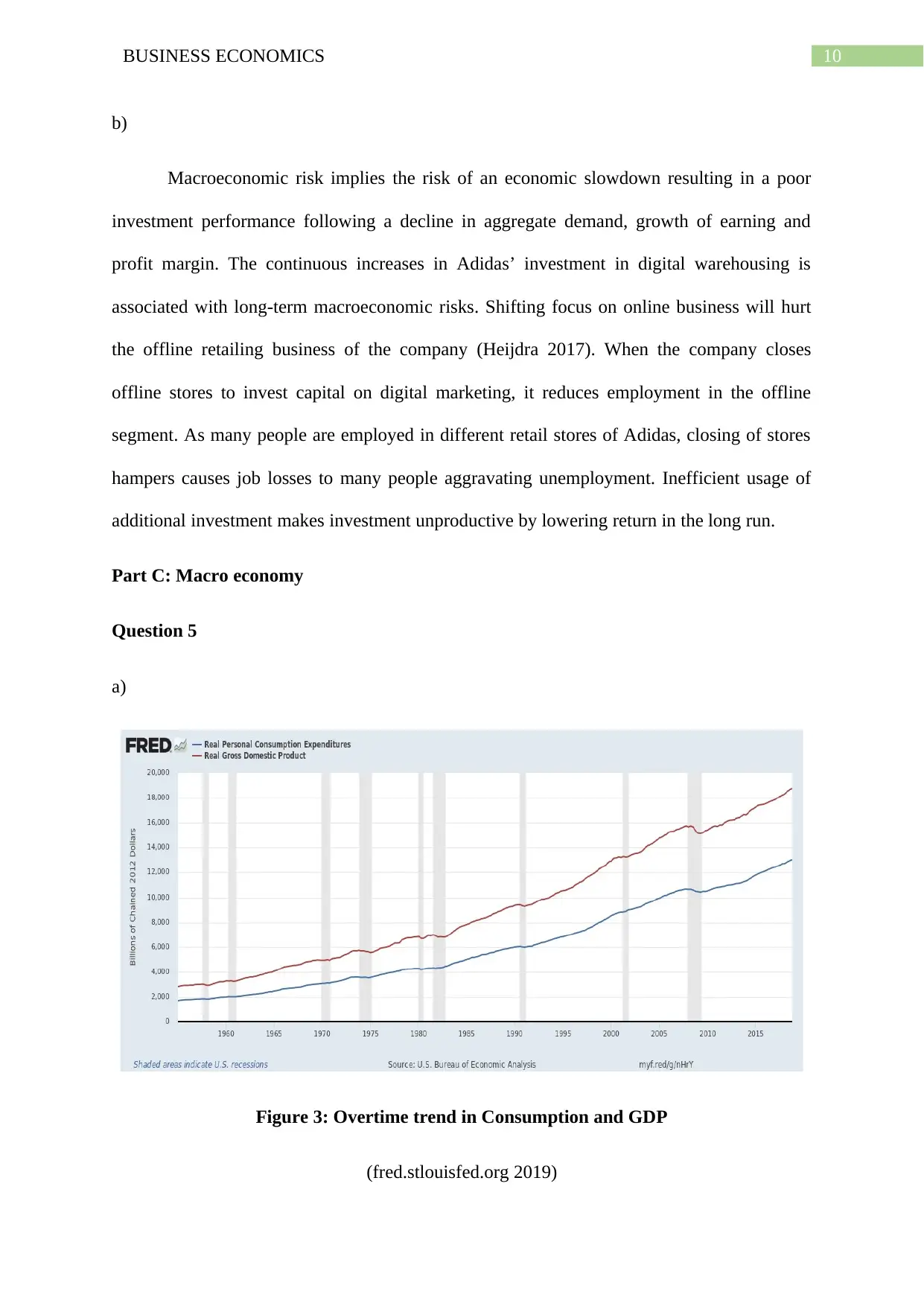
10BUSINESS ECONOMICS
b)
Macroeconomic risk implies the risk of an economic slowdown resulting in a poor
investment performance following a decline in aggregate demand, growth of earning and
profit margin. The continuous increases in Adidas’ investment in digital warehousing is
associated with long-term macroeconomic risks. Shifting focus on online business will hurt
the offline retailing business of the company (Heijdra 2017). When the company closes
offline stores to invest capital on digital marketing, it reduces employment in the offline
segment. As many people are employed in different retail stores of Adidas, closing of stores
hampers causes job losses to many people aggravating unemployment. Inefficient usage of
additional investment makes investment unproductive by lowering return in the long run.
Part C: Macro economy
Question 5
a)
Figure 3: Overtime trend in Consumption and GDP
(fred.stlouisfed.org 2019)
b)
Macroeconomic risk implies the risk of an economic slowdown resulting in a poor
investment performance following a decline in aggregate demand, growth of earning and
profit margin. The continuous increases in Adidas’ investment in digital warehousing is
associated with long-term macroeconomic risks. Shifting focus on online business will hurt
the offline retailing business of the company (Heijdra 2017). When the company closes
offline stores to invest capital on digital marketing, it reduces employment in the offline
segment. As many people are employed in different retail stores of Adidas, closing of stores
hampers causes job losses to many people aggravating unemployment. Inefficient usage of
additional investment makes investment unproductive by lowering return in the long run.
Part C: Macro economy
Question 5
a)
Figure 3: Overtime trend in Consumption and GDP
(fred.stlouisfed.org 2019)
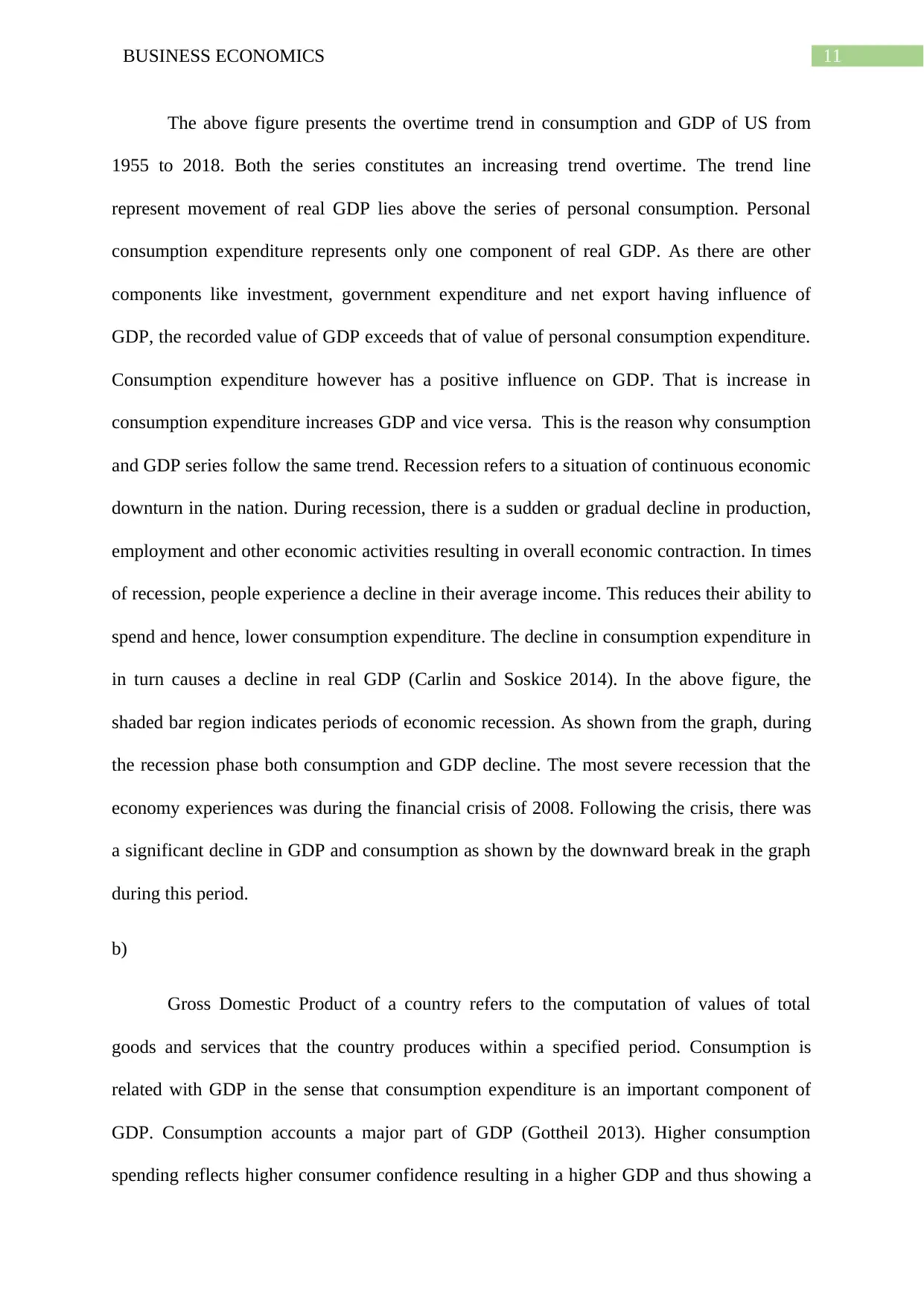
11BUSINESS ECONOMICS
The above figure presents the overtime trend in consumption and GDP of US from
1955 to 2018. Both the series constitutes an increasing trend overtime. The trend line
represent movement of real GDP lies above the series of personal consumption. Personal
consumption expenditure represents only one component of real GDP. As there are other
components like investment, government expenditure and net export having influence of
GDP, the recorded value of GDP exceeds that of value of personal consumption expenditure.
Consumption expenditure however has a positive influence on GDP. That is increase in
consumption expenditure increases GDP and vice versa. This is the reason why consumption
and GDP series follow the same trend. Recession refers to a situation of continuous economic
downturn in the nation. During recession, there is a sudden or gradual decline in production,
employment and other economic activities resulting in overall economic contraction. In times
of recession, people experience a decline in their average income. This reduces their ability to
spend and hence, lower consumption expenditure. The decline in consumption expenditure in
in turn causes a decline in real GDP (Carlin and Soskice 2014). In the above figure, the
shaded bar region indicates periods of economic recession. As shown from the graph, during
the recession phase both consumption and GDP decline. The most severe recession that the
economy experiences was during the financial crisis of 2008. Following the crisis, there was
a significant decline in GDP and consumption as shown by the downward break in the graph
during this period.
b)
Gross Domestic Product of a country refers to the computation of values of total
goods and services that the country produces within a specified period. Consumption is
related with GDP in the sense that consumption expenditure is an important component of
GDP. Consumption accounts a major part of GDP (Gottheil 2013). Higher consumption
spending reflects higher consumer confidence resulting in a higher GDP and thus showing a
The above figure presents the overtime trend in consumption and GDP of US from
1955 to 2018. Both the series constitutes an increasing trend overtime. The trend line
represent movement of real GDP lies above the series of personal consumption. Personal
consumption expenditure represents only one component of real GDP. As there are other
components like investment, government expenditure and net export having influence of
GDP, the recorded value of GDP exceeds that of value of personal consumption expenditure.
Consumption expenditure however has a positive influence on GDP. That is increase in
consumption expenditure increases GDP and vice versa. This is the reason why consumption
and GDP series follow the same trend. Recession refers to a situation of continuous economic
downturn in the nation. During recession, there is a sudden or gradual decline in production,
employment and other economic activities resulting in overall economic contraction. In times
of recession, people experience a decline in their average income. This reduces their ability to
spend and hence, lower consumption expenditure. The decline in consumption expenditure in
in turn causes a decline in real GDP (Carlin and Soskice 2014). In the above figure, the
shaded bar region indicates periods of economic recession. As shown from the graph, during
the recession phase both consumption and GDP decline. The most severe recession that the
economy experiences was during the financial crisis of 2008. Following the crisis, there was
a significant decline in GDP and consumption as shown by the downward break in the graph
during this period.
b)
Gross Domestic Product of a country refers to the computation of values of total
goods and services that the country produces within a specified period. Consumption is
related with GDP in the sense that consumption expenditure is an important component of
GDP. Consumption accounts a major part of GDP (Gottheil 2013). Higher consumption
spending reflects higher consumer confidence resulting in a higher GDP and thus showing a
⊘ This is a preview!⊘
Do you want full access?
Subscribe today to unlock all pages.

Trusted by 1+ million students worldwide
1 out of 15
Related Documents
Your All-in-One AI-Powered Toolkit for Academic Success.
+13062052269
info@desklib.com
Available 24*7 on WhatsApp / Email
![[object Object]](/_next/static/media/star-bottom.7253800d.svg)
Unlock your academic potential
Copyright © 2020–2026 A2Z Services. All Rights Reserved. Developed and managed by ZUCOL.





